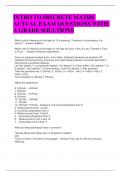INTRO TO DISCRETE MATHS
ACTUAL EXAM QUESTIONS WITH
A GRADE SOLUTIONS
Which rule of inference is the basis of "It is snowing. Therefore it is snowing or it is
sunny"? - Answer-Addition
Which rule of inference is the basis of "All cats are furry. Felix is a cat. Therefore, Felix
is Furry." - Answer-Universal instantiation
Fred is a graduate student and is from Idaho. Graduate students are students. All
students are hard working. Everyone from Idaho likes potatoes. Conclude that Fred is
hard working and likes potatoes.
Let G(x) denote "x is a graduate student," I(x) denote "x is from Idaho," S(x) denote "x is
a student," H(x) denote "x is hard working," and P(x) denote "x likes potatoes."
Then the premises are 1. G(Fred,) 2. I(Fred,) 3. ∀xG(x) →S(x), 4. ∀xS(x)→H(x), 5.
∀xI(x)→P(x).
The conclusion is H(Fred) ^ P(Fred.)
Match the statements.
6. G(Fred) → S(Fred)
7. S(Fred)
8. S(Fred) → H(Fred)
9. H(Fred)
10. I(Fred) → P(Fred)
11. P(Fred)
12. H(Fred) ^ P(Fred) - Answer-6. Universal instantiation from 3
2. Modus ponens from 1 and 6
3. Universal instantiation from 4
4. Modus ponens from 7 and 8
5. Universal instantiation from 5
6. Modus ponens from 2 and 10
7. Conjunction from 9 and 11
What do these sentences have in common?
"George Boole was either born in England or Ireland"
and
"Carol is either in the attic or the garage" - Answer-They use Or with an exclusive
Meaning.
,George could not be born in both places, and Carol could not be in two places at once.
What do these sentences have in common?
"No service without shirt or shoes."
and
"I'm available on Friday's after 4:00 or Wednesday's before 2:00" - Answer-They use Or
with an inclusive Meaning.
They will not serves someone without a shirt, without shoes, or without both shoes and
a shirt.
She is available on both days, so it is OR.
For which predicts P is the statement ∀xP(x) true, where the domain is the positive
integers?
1. P(x) is the statement "x^2 >x"
2. P(x) is the statement "x >2"
3. P(x) is the statement "x > 0"
4. P(x) is the statement "x^2 >= x" - Answer-3. P(x) is the statement "x > 0"
4. P(x) is the statement "x^2 >= x"
What makes these true?
1. ∃x(x>5)
2. ∃x(x=< 0)
3. ∃x(x^2 =1) - Answer-1. {2,4,7} The number 7 satisfies it
2. {-5,5} The number -5 satisfies it
3. {1,2,3,4,5} The number 1 satisfies it
What belongs under the proposition ∃xP(x) ?
1. There Exists an x such that P(x)
2. For some x, P(x)
3. There is an x such that P(x)
4. There is at least one x such that P(x)
5. For an arbitrary x P(x)
6. For all x P(x)
7. P(x) is true for each x
8. For every x p(x) - Answer-1. There Exists an x such that P(x)
2. For some x, P(x)
3. There is an x such that P(x)
4. There is at least one x such that P(x)
What belongs under the proposition ∀xP(x) ?
1. There Exists an x such that P(x)
2. For some x, P(x)
, 3. There is an x such that P(x)
4. There is at least one x such that P(x)
5. For an arbitrary x P(x)
6. For all x P(x)
7. P(x) is true for each x
8. For every x p(x) - Answer-5. For an arbitrary x P(x)
6. For all x P(x)
7. P(x) is true for each x
8. For every x p(x)
What is the predicate calculus translation for the following?
1. There is exactly one student in this class who has a perfect score.
2. All students in the class have a perfect score.
3. At least one student in the class has a perfect score.
4. There is no one in the class with a perfect score.
5. There is exactly one student in this class, and that student has a perfect score. -
Answer-1. ∃x((C(x) ^ P(x)) ^ ∀y((y =/ x) → ¬(C(x)^P(x))))
2. ∀x(C(x) → P(x))
3. ∃x(C(x)^P(x))
4. ∀x(¬C(x) V ¬P(x))
5. ∃x((C(x)^P(x)) ^ ∀y(C(y) → (y=x)))
For which of the following is ∀x∀y∃zQ(x,y,z) true? Assuming the domain of
quantification for all variables is real numbers.
1. Let Q(x,y,z) be the statement "(xy) / z = x / (yz)"
2. Let Q(x,y,z) be the statement "xy =z"
3. Let Q(x,y,z) be the statement "x / y =z"
4. Let Q(x,y,z) be the statement "(xy)z=x(yz)" - Answer-2. Let Q(x,y,z) be the statement
"xy =z"
4. Let Q(x,y,z) be the statement "(xy)z=x(yz)"
Fill in the blanks.
Moving a negation inward over a disjunction changes the disjunction into a and
each of the two statements is . Moving a negation inward over an existential
quantifier changes the quantifier to a quantifier and the rest of the expression is
negated. Moving a negation inward over an universal quantifier changes the quantifier
to an quantifier and the rest of the expression is negated. - Answer-1. Conjunction
2. Negated
3. Universal
4. existential
Which rule of inference is the basis of "If it rains, the the grass grows. It is raining.
Therefore, the grass grows." - Answer-Modus ponens




